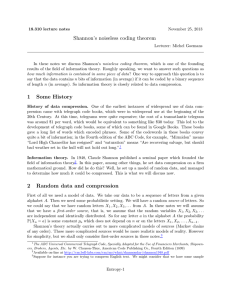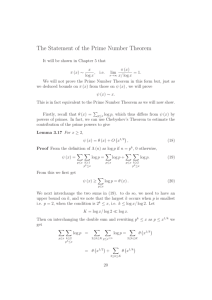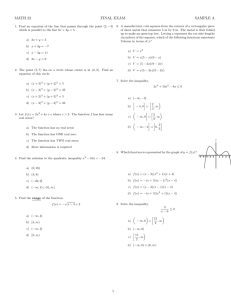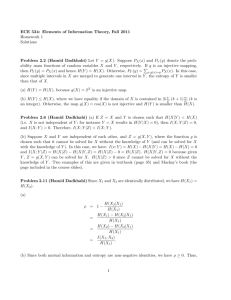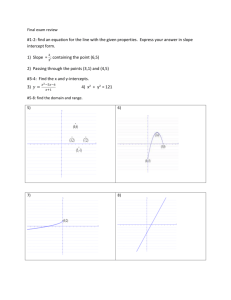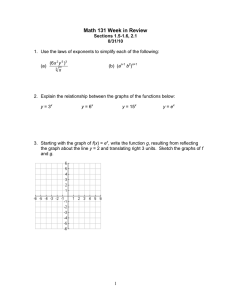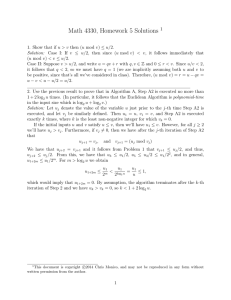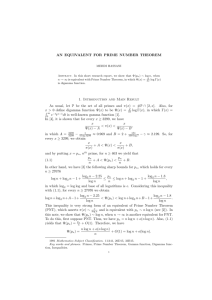Shannon’s noiseless coding theorem
advertisement
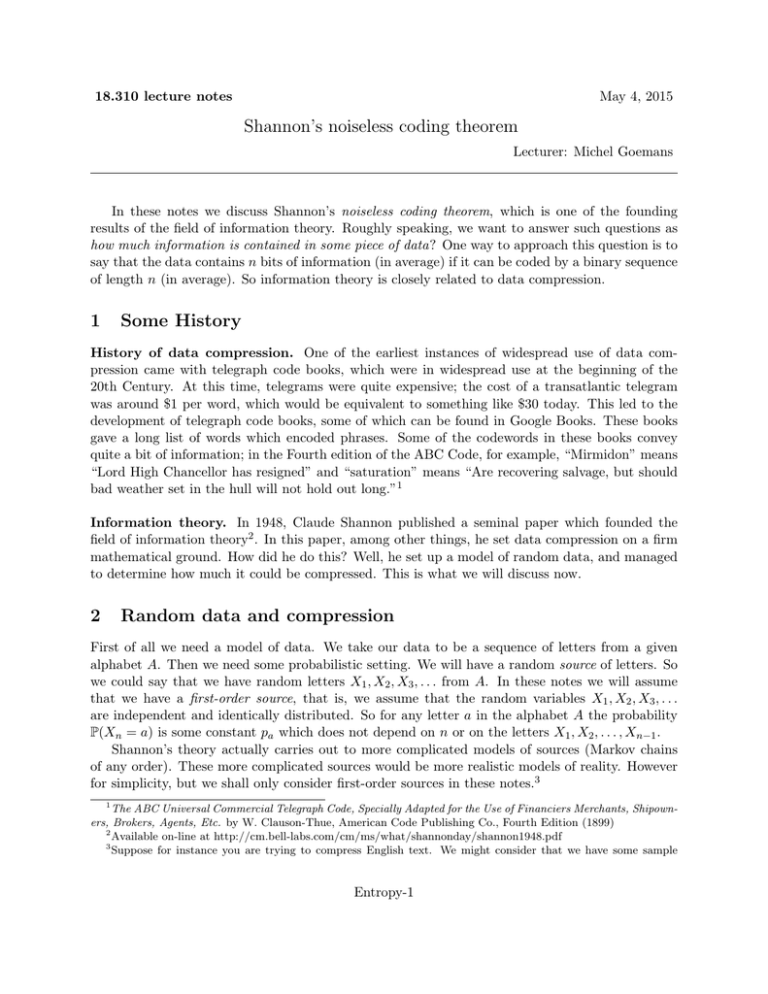
18.310 lecture notes
May 4, 2015
Shannon’s noiseless coding theorem
Lecturer: Michel Goemans
In these notes we discuss Shannon’s noiseless coding theorem, which is one of the founding
results of the field of information theory. Roughly speaking, we want to answer such questions as
how much information is contained in some piece of data? One way to approach this question is to
say that the data contains n bits of information (in average) if it can be coded by a binary sequence
of length n (in average). So information theory is closely related to data compression.
1
Some History
History of data compression. One of the earliest instances of widespread use of data compression came with telegraph code books, which were in widespread use at the beginning of the
20th Century. At this time, telegrams were quite expensive; the cost of a transatlantic telegram
was around $1 per word, which would be equivalent to something like $30 today. This led to the
development of telegraph code books, some of which can be found in Google Books. These books
gave a long list of words which encoded phrases. Some of the codewords in these books convey
quite a bit of information; in the Fourth edition of the ABC Code, for example, “Mirmidon” means
“Lord High Chancellor has resigned” and “saturation” means “Are recovering salvage, but should
bad weather set in the hull will not hold out long.”1
Information theory. In 1948, Claude Shannon published a seminal paper which founded the
field of information theory2 . In this paper, among other things, he set data compression on a firm
mathematical ground. How did he do this? Well, he set up a model of random data, and managed
to determine how much it could be compressed. This is what we will discuss now.
2
Random data and compression
First of all we need a model of data. We take our data to be a sequence of letters from a given
alphabet A. Then we need some probabilistic setting. We will have a random source of letters. So
we could say that we have random letters X1 , X2 , X3 , . . . from A. In these notes we will assume
that we have a first-order source, that is, we assume that the random variables X1 , X2 , X3 , . . .
are independent and identically distributed. So for any letter a in the alphabet A the probability
P(Xn = a) is some constant pa which does not depend on n or on the letters X1 , X2 , . . . , Xn−1 .
Shannon’s theory actually carries out to more complicated models of sources (Markov chains
of any order). These more complicated sources would be more realistic models of reality. However
for simplicity, but we shall only consider first-order sources in these notes.3
1
The ABC Universal Commercial Telegraph Code, Specially Adapted for the Use of Financiers Merchants, Shipowners, Brokers, Agents, Etc. by W. Clauson-Thue, American Code Publishing Co., Fourth Edition (1899)
2
Available on-line at http://cm.bell-labs.com/cm/ms/what/shannonday/shannon1948.pdf
3
Suppose for instance you are trying to compress English text. We might consider that we have some sample
Entropy-1
Now we need to say what data compression means. We shall encode data by binary sequences
(sequences of 0 and 1). A coding function φ for a set S of messages is simply a function which
associates to each element s ∈ S a distinct binary sequence φ(s). Now if the messages s in S have a
certain probability distribution then the length L of the binary sequence φ(s) is a random variable.
We are looking for codes such that the average length E(L) is as small as possible. In our context,
the random messages will be the sequences s = (X1 , X2 , . . . , Xn ) consisting of the first n letters
coming out of the source. One way to encode these messages is to attribute distinct binary sequences
of length dlog2 (|A|)e to the letters in the alphabet A. Then the binary sequence φ(s) would be the
concatenation of the codes of the letter, so that the length L of φ(s) would be ndlog2 (|A|)e. That’s
a perfectly valid coding function, leading to average length E(L) = ndlog2 (|A|)e. Now the main
question is: can we do better? How much better? This is what we discuss next.
3
Shannon’s entropy Theorem
Consider an alphabet A = {a1 , . . . , ak } and a first-order source X as above: the nth (random)
letter is denoted Xn . For all i ∈ {1, . . . , k} we denote by pi the probability of the letter ai , that is,
P(Xn = ai ) = pi . We define the entropy of the source X as
H(p) = −
k
X
pi log2 (pi ).
i=1
We often denote the entropy just by H, without emphasizing the dependence on p. The entropy
H(p) is a nonnegative number. It can also be shown that H(p) ≤ log2 (k) by concavity of the
logarithm. This upper bound is achieved when p1 = p2 = . . . = pk = 1/k. We will now discuss and
prove (leaving a few details out) the following result of Shannon.
Theorem 1 (Shannon’s entropy Theorem). Let X be a first order source with entropy H. Let φ be
any coding function (in binary words) for the sequences s = (X1 , X2 , . . . , Xn ) consisting of the first
n letters coming out of the source. Then the length L of the code φ(s) is at least H n on average,
that is,
E(L) ≥ H n + o(n),
where the “little o” notation means that the expression divided by n goes to zero as n goes to infinity.
Moreover, there exists a coding function φ such that
E(L) ≤ H n + o(n).
corpus of English text on hand (say, everything in the Library of Congress). Shannon considered a series of sources,
each of which is a better approximation to English. The first-order source which emits a letter a with probability pa
which is proportional to its frequency in the text. The probability distribution of a sequence of n letters from this
source is just n independent random variables where the letter aj appears with some probability pj . The secondorder source is that where a letter is emitted with probability that depends only on the previous letter, and these
probabilities are just the conditional probabilities that appear in the corpus (that is, the conditional probability of
getting a ’u’, given that the previous letter was a ’q’, is derived by looking at the frequency of all letters that follow
a ’q’ in the corpus). In the third-order source, the probability of a letter depends only on the two previous letters,
and so on. High-order sources would seem to give a pretty good approximation of English, and so it would seem that
a compression method that works well on this class of sources would also work well on English text.
Entropy-2
So the entropy of the source tells you how much the messages coming out of it can be compressed.
Another way of interpreting this theorem is to say that the amount of information coming out of
the source is “H bits of informations per letters”.
We will now give a sketch of the proof of Shannon’s entropy Theorem. First, let’s try to show
that one cannot compress the source too much. We look at a sequence of n letters from the
first-order source X, with the probability of letter ai being pi for all i in [k].
First observe that the number of sequences of length n with exactly ni letter ai is
n
n!
=
,
n1 , n2 , . . . , nk
n1 !n2 ! · · · nk !
and all these words have the same probability pn1 1 pn2 2 · · · pnk k . Now, if we have some number M of
equally likely messages that must be sent, then in order to send them we need to use log M bits on
average (see the counting notes). So we need to send at least
n
log2
n1 , n2 , . . . , nk
bits. To approximate this, we can use Stirling’s formula
n n
√
n! ∼ 2πn
.
e
It gives
log2 (n!) = n log2 (n) − n log2 (e) + o(n).
Using this formula one obtains
log2
n
n1 , n2 , . . . , nk
= log2 (n!) −
k
X
log2 (ni !)
i=1
k
X
= n log2 (n) −
ni log2 (ni ) + o(n)
i=1
= −
k
X
ni log2 (ni /n) + o(n).
i=1
In terms of the entropy function, this can be rewritten as:
n
nk n
1
log2
= nH
,··· ,
+ o(n).
n1 , n2 , . . . , nk
n
n
So we have a conditional lower bound on the length of the coding sequences
E(L|n1 , . . . , nk ) ≥ −
k
X
ni log2 (ni /n) + o(n).
(1)
i=1
In particular if ni = pi n for all i one gets E(L|n1 , . . . , nk ) ≥ −
Entropy-3
Pk
i=1 n pi log2 (pi )+o(n)
= n H +o(n).
Now we want to find what ni is in general. The expectation of ni is npi . Moreover it can be
shown that ni is very concentrated around this expectation. Actually, using Chebyshev’s inequality
one can prove (do it!) that for any constant > 0
P (|ni − npi | ≥ n) ≤
pi (1 − pi )
.
2 n
Now we fix a constant > 0 and we consider two cases. We define a sequence of letters to be
-typical if |ni − npi | ≤ n for all i and -atypical otherwise. By the union bound, the above gives
a bound on the probability to be -atypical:
P(-atypical) ≤
k
X
pi (1 − pi )
i=1
2 n
≤
1
.
2 n
Moreover Equation (1) gives
E(L|-typical) ≥ −n
k
X
(pi − ) log2 (pi + ) + o(n).
i=1
We now use the linearity of expectation to bound the length of the coded message:
E(L) = E(L|−typical)P(−typical) + E(L|−atypical)P(−atypical)
≥ (−n
k
X
(pi − ) log2 (pi + ) + o(n)) · (1 −
i=1
1
).
2 n
Since one can take as small as one wants, this shows that
E(L) ≥ n H + o(n).
So we have proved the first part of the Shannon entropy theorem.
We now will show that one can do compression and get coded messages of length no more
than Hn in average. We use again the linearity of expectation to bound the length of the coded
messages:
E(L) = E(L|−typical)P(−typical) + E(L|−atypical)P(−atypical).
Now, we need to analyze this expression. P(atypical) ≤ nc , so as long as we don’t make the output in
the atypical case more than length Cn, we can ignore the second term, as this one will be constant
while the first term will be linear. What we could do is use one bit to tell the receiver whether the
output was typical and atypical. If it is atypical, we can send it without compression (thus sending
log2 (k n ) = n log2 (k)), and if it typical, we can then compress it. The dominant contribution to the
expected length then occurs from typical outputs, because of the rarity of atypical ones.
How do we compress the source output if it’s typical? One of the simplest ways theoretically
(but this is not practical) is to calculate the number of typical outputs, and then assign a number
(in binary representation) to each output. This compresses the source to log2 of the number of
typical outputs. We will do this and get an upper bound of nH + o(n) bits, where the “little o”
notation means that the expression divided by n goes to zero as n goes to infinity.
Entropy-4
How do we calculate the number of typical outputs? For each typical vector of numbers ni , we
have that the number of outputs is
n
n1 , n2 , . . . , nk .
So an upper bound on the total number of typical outputs is
k
X
X
i=1 ni :npi −≤ni ≤npi +
n
,
n1 , n2 , . . . , nk
P
this is an upper bound as we haven’t taken into account that ni=1 ni = n. But we can even use
an even cruder upper bound by upper bounding the number of terms in the summation by nk (it
is not necessary to use the improved (2n)k ). Thus, we get that the number of typical outputs is
n
k
≤n
,
(p1 ± )n, (p2 ± )n, . . . , (pk ± )n
where we can choose the pi ± to maximize the expression. Taking logs, we get that the number
of bits required to send a typical output is at most
k log2 n + nH + cn,
for some constant c. The first term is negligible for large n, and we can let go to zero as n goes
to ∞ so as to get compression to nH + o(n) bits.
In summary, Shannon’s noiseless theorem says that we need to transmit H n bits and this is
can be essentially achieved. We’ll see next a much more practical way (Huffman codes) to do the
compression and although it often does not quite achieve the Shannon bound, it gets fairly close
to it.
Entropy-5

